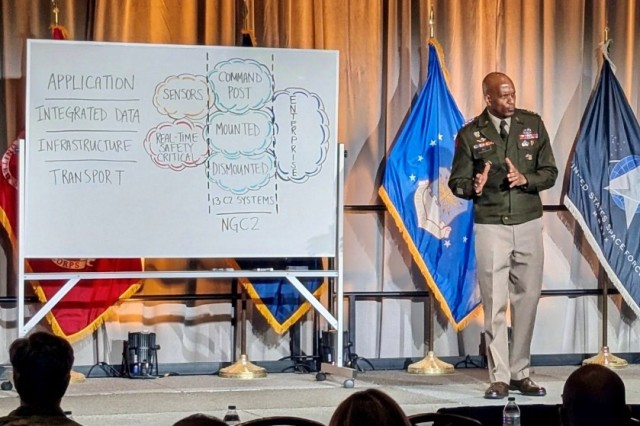
VIEW ORIGINAL
WASHINGTON — The Army is undergoing a significant transformation, shifting its focus to a data-centric approach to ensure warfighting superiority in future conflicts, said Lt. Gen. Jeth Rey, deputy chief of staff, G-6, Pentagon, during a conference last week.
The G-6 is the principle military advisor to the Army chief of staff and the chief information officer for planning, strategy, network architecture, and the implementation of command, control, communications, cyber operations and networks for worldwide Army operations.
“This fight is moving very fast. We have to be ahead of our adversary,” Rey said.
Future warfare
Future battles could include cyber attacks, autonomous drones, electronic warfare and artificial intelligence-driven decision making by adversaries.
“The next war may not be kinetic only,” Rey said. “It’s going to be non-kinetic.”
He highlighted the impact of drones and the vulnerability of critical infrastructure in Ukraine as an example.
“Drones are changing the way we do business,” Rey said. “Look at our critical infrastructure. Think about what could happen if a non-kinetic strike does hit us. Those blackouts we’ve been experiencing, we shouldn’t take those lightly. We should be digging in to understand what’s behind them.”
Rey and his team met with Soldiers to discuss the focus on enhancing warfighting mentality, cyber transformation and enabling data-driven decision making. He said the Army is prioritizing electronic warfare and the electronic spectrum.
“We’re going to work together to train, find the capabilities, and then employ those so the commanders can have a better, informed decision of what they look like inside the spectrum. It is congested and contested every day. It’s our job to figure that out, with industry partners helping us all the way.”
Data advantage
The Army’s transformation involves a shift from viewing the network as an end in itself to recognizing it as a pathway to data. The goal is to deliver the right data to the right warfighter at the right time in a secure manner, enabling efficient, quality decisions.
Currently, commanders are overwhelmed by the volume of data they receive on the battlefield, Rey said.
“It’s data overload,” he said. “We still have to find out how to use emerging technologies, AI tools, in order to help us with the commanders to make better and more informed decisions. That is the instinct we’re looking for.”
Network, C2 modernization
To achieve this data-centric vision, Rey said the Army will modernize its network and command and control systems. The Army Unified Network Plan focuses on modernizing the network across the Army and evolving it into a global information technology warfighting decision-making platform. The plan prioritizes data centricity and incorporates zero trust architecture.
The next generation command and control initiative aims to accelerate C2 modernization across the Army, retiring legacy systems and investing in a “full stack” capability ecosystem with AI tools to analyze data. The goal is to put these transport and infrastructure layer capabilities in the hands of the warfighters within 30 months.

“We are working to put commander back into command and control,” Rey said.
He said commanders must have assured communications via the six computing environments, which eventually collapse down to two, information technology and operational technology. Communications runs from the enterprise side to dismounted and handhelds to tanks, helicopters and command posts to sensors.
The next generation C2 will replace 13 C2 systems with an ecosystem that has large language models, AI and machine learning to ingest intel, sustainment and fires data.
Industry partnership
Rey emphasized the importance of collaboration with industry partners to achieve the Army's transformation goals. Industry partners can help the Army overcome legacy architectures, foster innovation, and provide systems built with cyber protection.
He said the future fight will be complex and cyber-focused; the ultimate goal will be to provide Soldiers the data they need to make rapid decisions on the battlefield.
“Our solution is a strong, data-driven network for our Army. It’s not just about technology. It’s about people,” Rey said. “Leaders, I need you to invest in your teams. Train as you fight. Encourage innovation, that’s what it’s all about.”
He said the Army’s goal is to have Soldiers who are ready to win the war anytime, anywhere. The Army can do this by giving them the data they need to make decisions faster than their adversaries.
“Our success, their lives depend on what we’re doing each and every day,” Rey said. “We can’t fail.”


Social Sharing